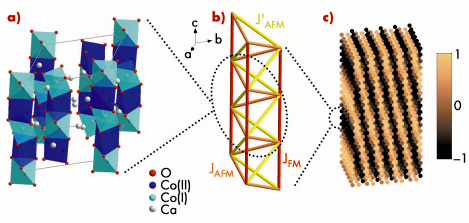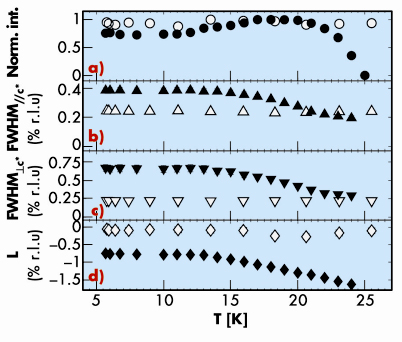- Home
- Users & Science
- Scientific Documentation
- ESRF Highlights
- ESRF Highlights 2008
- X-ray absorption and magnetic scattering
- Revealing the magnetic ground state of Ca3Co2O6
Revealing the magnetic ground state of Ca3Co2O6
The study of frustration offers challenges to both theoreticians and experimentalists alike. New states, often characterised by peculiar static and dynamic properties, are created as a result of competing interactions. In particular, when acting in magnetic systems, frustration reveals many of its most intriguing aspects and careful investigations of specific systems can produce fascinating new science.
In this respect, Ca3Co2O6 is a very interesting system, characterised by low dimensional magnetism and topological frustration. Figure 106a, shows the crystallographic structure of the compound, made up of chains of face-sharing polyhedra running along the c-axis, arranged in the ab-plane on a triangular lattice. Due to local symmetry, one half of the Co ions have a magnetic moment (Co(II), µ ~5.1 µB), subject to (antiferro-)ferromagnetic (inter-)intrachain interactions. In the sketch, magnetic sites are located at the centre of dark blue polyhedra, representing oxygen cages with trigonal prismatic coordination.
 |
|
Fig. 106: a) Ca3Co2O6 hexagonal cell, octahedral Co(I) and trigonal Co(II) sites are shown in light and dark blue, respectively; b) proposed magnetic exchange pattern between the Co(II) sites; c) sketch showing one possible arrangement of the normalised Co(II) magnetic moments in the incommensurate magnetic ground state (µ \\ c-axis, shown vertical). Some modifications to the cell and the propagation vector length have been applied for the sake of clarity. |
Ca3Co2O6 has been the focus of considerable experimental and theoretical attention due to its peculiar magnetic properties. Below the Neel temperature (TN ~25 K), 3D long range magnetic order is established. At low temperature, an unexpected evolution of the magnetic order parameter versus both temperature and magnetic field is observed. In particular, diffracted intensities corresponding to antiferromagnetic (AFM) reflections (Figure 107 upper panel) decrease on cooling below 17 K, while the bulk magnetisation increases in a series of equally spaced steps versus the magnetic field, instead of smoothly approaching its saturation value. Depending on external conditions, the relaxation of the magnetisation towards its equilibrium state can also be dramatically modified.
It is clear that a simple AFM model is not able to account for the complexity of the magnetic ground state of Ca3Co2O6. For this reason, we decided to investigate the magnetic properties of Ca3Co2O6 using resonant magnetic X-ray scattering (RMXS) [1]. By studying AFM reflections in zero magnetic field and at low temperature, we found evidence that the system adopts an incommensurate magnetic state immediately below TN. The characteristic temperature evolution of a typical Bragg forbidden AFM reflection in resonant conditions is shown in Figure 107. Our results rule out a number of previously proposed magnetic structures, and pose serious new constraints on the description of the system.
 |
|
Fig. 107: Temperature evolution of a Bragg forbidden AFM reflection (320) and a charge reflection (330), in black and grey symbols, respectively. |
To complete the overview of the properties of the magnetic state and to access as much information as possible in reciprocal space, we performed a complementary neutron powder diffraction (NPD) experiment [2]. Using symmetry analysis and by considering the possible exchange pathways within the material (Figure 106b: exchange paths connecting magnetic trigonal sites are represented) we showed that Ca3Co2O6 adopts a longitudinal incommensurate magnetic structure in the form of a sinusoidal wave propagating along the c-axis chains (at T = 18 K the propagation vector is k~(0, 0, 0.01)). The modulation is phase shifted by 1/3 on moving from one chain to the next, resulting in the magnetic moment arrangement as shown in Figure 106c.
As a result of our investigations, exploiting RMXS and NPD techniques, we have demonstrated that the three dimensional nature of the magnetic exchange coupling in Ca3Co2O6 must be taken into account in order to properly describe the magnetic ground state realised in this low dimensional system. Figure 106b shows a proposed exchange pattern (JFM>> JAFM, J’AFM) compatible with the magnetic ground state. Our results challenge the existing theories describing the magnetic properties of Ca3Co2O6 and provide a basis for future investigations of the unusual and as yet unexplained static (magnetisation steps) and dynamic (relaxation of the magnetisation) properties of this system.
Authors
S. Agrestini (a), A. Bombardi (b), C. Mazzoli (c), L. Chapon (d) and M.R. Lees (e).
(a) Laboratoire CRISMAT, UMR 6508 CNRS-ENSICAEN, Caen (France)
(b) Diamond Light Source Ltd., Rutherford Appleton Laboratory, Chilton-Didcot (UK)
(c) ESRF
(d) ISIS Facility, Rutherford Appleton Laboratory, Chilton-Didcot (UK)
(e) Department of Physics, University of Warwick, Coventry (UK)
References
[1] S. Agrestini et al., Phys. Rev. B 77, 140403R (2008); A. Bombardi et al., Phys. Rev. B 78, 100406R (2008).
[2] S. Agrestini et al.,. Phys. Rev. Lett. 101, 097207 (2008).



